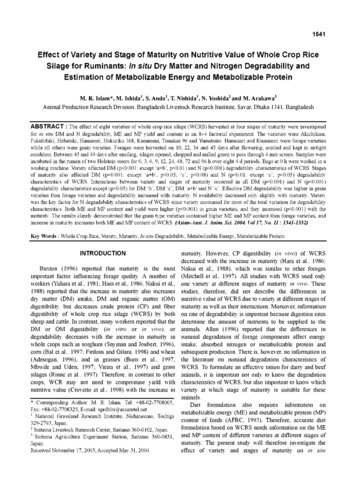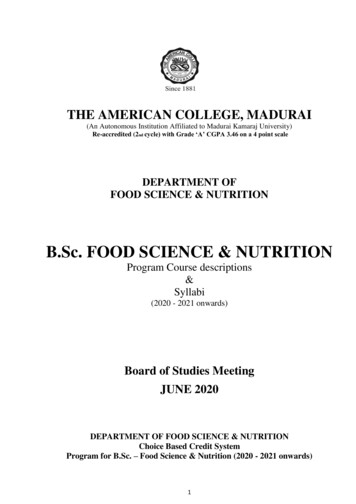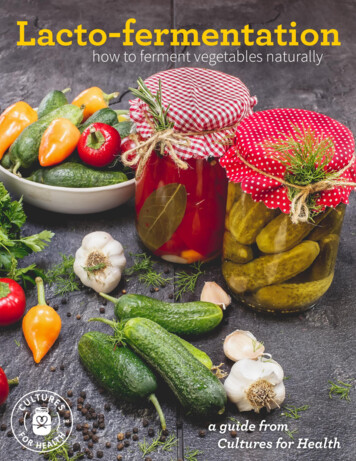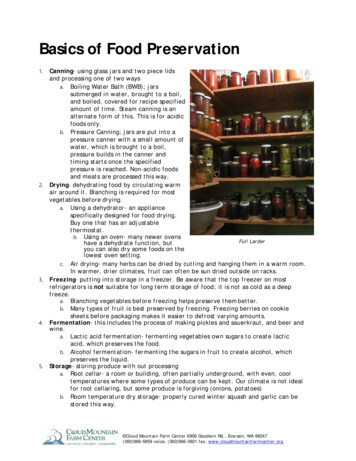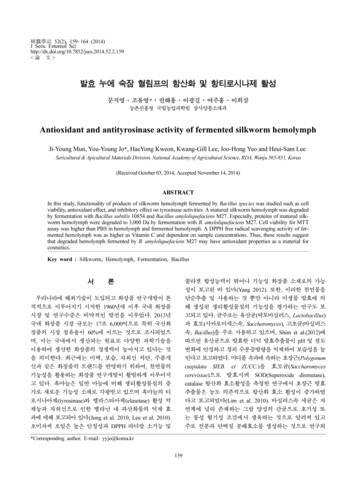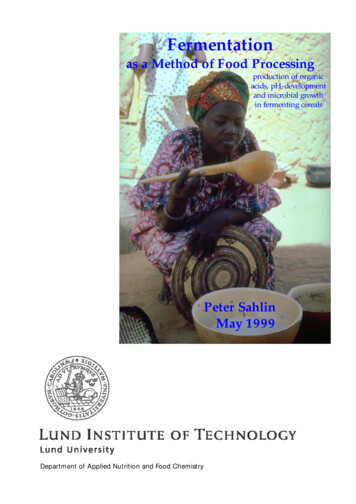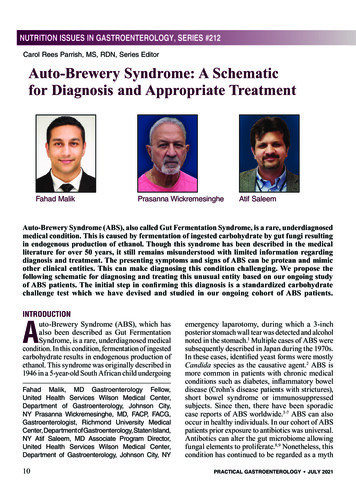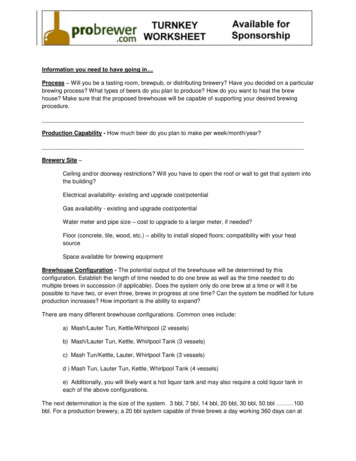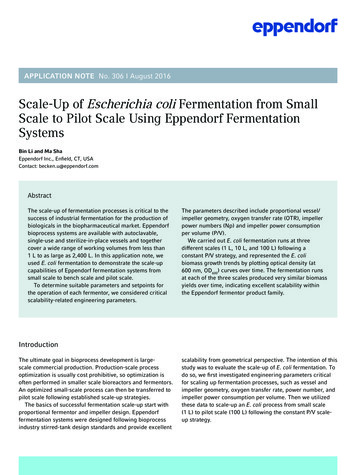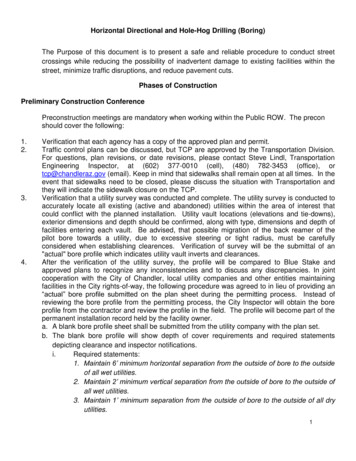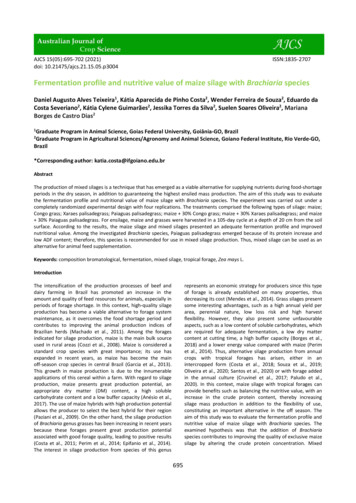
Transcription
AJCS 15(05):695-702 (2021)doi: tion profile and nutritive value of maize silage with Brachiaria speciesDaniel Augusto Alves Teixeira1, Kátia Aparecida de Pinho Costa2, Wender Ferreira de Souza2, Eduardo daCosta Severiano2, Kátia Cylene Guimarães2, Jessika Torres da Silva2, Suelen Soares Oliveira2, MarianaBorges de Castro Dias21Graduate Program in Animal Science, Goias Federal University, Goiânia-GO, BrazilGraduate Program in Agricultural Sciences/Agronomy and Animal Science, Goiano Federal Institute, Rio Verde-GO,Brazil2*Corresponding author: katia.costa@ifgoiano.edu.brAbstractThe production of mixed silages is a technique that has emerged as a viable alternative for supplying nutrients during food-shortageperiods in the dry season, in addition to guaranteeing the highest ensiled mass production. The aim of this study was to evaluatethe fermentation profile and nutritional value of maize silage with Brachiaria species. The experiment was carried out under acompletely randomized experimental design with four replications. The treatments comprised the following types of silage: maize;Congo grass; Xaraes palisadegrass; Paiaguas palisadegrass; maize 30% Congo grass; maize 30% Xaraes palisadegrass; and maize 30% Paiaguas palisadegrass. For ensilage, maize and grasses were harvested in a 105-day cycle at a depth of 20 cm from the soilsurface. According to the results, the maize silage and mixed silages presented an adequate fermentation profile and improvednutritional value. Among the investigated Brachiaria species, Paiaguas palisadegrass emerged because of its protein increase andlow ADF content; therefore, this species is recommended for use in mixed silage production. Thus, mixed silage can be used as analternative for animal feed supplementation.Keywords: composition bromatological, fermentation, mixed silage, tropical forage, Zea mays L.IntroductionThe intensification of the production processes of beef anddairy farming in Brazil has promoted an increase in theamount and quality of feed resources for animals, especially inperiods of forage shortage. In this context, high-quality silageproduction has become a viable alternative to forage systemmaintenance, as it overcomes the food shortage period andcontributes to improving the animal production indices ofBrazilian herds (Machado et al., 2011). Among the foragesindicated for silage production, maize is the main bulk sourceused in rural areas (Cozzi et al., 2008). Maize is considered astandard crop species with great importance; its use hasexpanded in recent years, as maize has become the mainoff-season crop species in central Brazil (Garcia et al., 2013).This growth in maize production is due to the innumerableapplications of this cereal within a farm. With regard to silageproduction, maize presents great production potential, anappropriate dry matter (DM) content, a high solublecarbohydrate content and a low buffer capacity (Anésio et al.,2017). The use of maize hybrids with high production potentialallows the producer to select the best hybrid for their region(Paziani et al., 2009). On the other hand, the silage productionof Brachiaria genus grasses has been increasing in recent yearsbecause these forages present great production potentialassociated with good forage quality, leading to positive results(Costa et al., 2011; Perim et al., 2014; Epifanio et al., 2014).The interest in silage production from species of this genusrepresents an economic strategy for producers since this typeof forage is already established on many properties, thusdecreasing its cost (Mendes et al., 2014). Grass silages presentsome interesting advantages, such as a high annual yield perarea, perennial nature, low loss risk and high harvestflexibility. However, they also present some unfavourableaspects, such as a low content of soluble carbohydrates, whichare required for adequate fermentation, a low dry mattercontent at cutting time, a high buffer capacity (Borges et al.,2018) and a lower energy value compared with maize (Perimet al., 2014). Thus, alternative silage production from annualcrops with tropical forages has arisen, either in anintercropped form (Costa et al., 2018; Souza et al., 2019;Oliveira et al., 2020; Santos et al., 2020) or with forage addedin the annual culture (Cruvinel et al., 2017; Paludo et al.,2020). In this context, maize silage with tropical forages canprovide benefits such as balancing the nutritive value, with anincrease in the crude protein content, thereby increasingsilage mass production in addition to the flexibility of use,constituting an important alternative in the off season. Theaim of this study was to evaluate the fermentation profile andnutritive value of maize silage with Brachiaria species. Theexamined hypothesis was that the addition of Brachiariaspecies contributes to improving the quality of exclusive maizesilage by altering the crude protein concentration. Mixed695
silages present a better fermentative profile compared withthat of the exclusive silages of Brachiaria species.ResultsThe fermentation characteristics: pH, buffer capacity, aracteristics: dry matter (DM), crude protein (CP), etherextract (EE), total digestible nutrients (TDN), neutral detergentfibre (NDF), acid detergent fibre (ADF), lignin and in vitro drymatter digestibility (IVDMD) were influenced (p 0.05) by thedifferent treatments.The evaluation of the pH (Table 2) showed the lowest value forexclusive maize silage, followed by maize silage with theaddition of 30% Brachiaria species. The highest values werefound for the exclusive grass silages, which showed increasesof 28.37 and 13.09%, respectively, in relation to the maizesilage and that with the addition of Brachiaria species.A similar behaviour to that of the pH occurred with the buffercapacity (Table 2), where the exclusive maize silage presentedthe lowest value, while the exclusive grass silages exhibitedhigher values. The inclusion of Brachiaria species in the maizesilage at 30% resulted in a reduction in the buffer capacity.Higher N-NH3 contents were observed for exclusive Brachiariaspecies silages (Table 2), while maize silage exhibited lowerprotein deterioration, resulting in lower N-NH3 contentscompared with those of the other silages. The inclusion of 30%grasses in maize silage also reduced the N-NH3 content.The exclusive Brachiaria species silages presented the lowestDM content, differing from the exclusive maize silage and maizewith 30% Xaraes and Paiaguas palisadegrass (Table 2). Maizesilage presented a higher DM content compared with that ofthe other silages.When the lactic acid concentration of the silages wasdetermined (Table 3), higher values were observed for maizesilage (p 0.05). In contrast, the Brachiaria species silagesshowed lower lactic acid concentrations. The 30% grass additionhad a positive effect since the lactic acid concentrationincreased compared with that in the exclusive grass silages.For the determination of the acetic and butyric acidconcentrations (Table 3), the Brachiaria species silagesexhibited higher contents compared with the exclusive maizesilage (p 0.05). The mixed silages presented mean values of5.58 and 0.22 g kg-1 DM for acetic and butyric acids,respectively. For the propionic acid concentration, only themaize silage was different (p 0.05) from the other silages.For the silage nutritive quality, the Paiaguas palisadegrasssilage stood out, exhibiting a higher CP value, representing a57.50% increase compared with that for maize silage (Table 4).Regarding the EE content, a higher value was observed inexclusive maize silage (Table 4), differing from the results forthe grass and mixed silages. However, the inclusion ofBrachiaria species at 30% resulted in an increase in the EEcontent compared with that of the exclusive grass silages.For the determination of silage TDN contents (Table 4), adirect relationship with the EE was observed. As the silagespresented higher EE values, they showed an increase in TDNcontents. Therefore, it was verified that the highest EE andTDN contents were observed for exclusive maize silage.The highest NDF contents (Table 5) were observed inBrachiaria species silages. The tropical grass inclusion in maizesilage provided lower NDF contents compared with those ofexclusive grass silages.696For ADF and lignin contents (Table 5), it was observed thatCongo grass and Xaraes palisadegrass silages exhibited thehighest ADF values. Moreover, Paiaguas palisadegrass silagepresented average ADF and lignin contents similar to mixedsilages. However, exclusive maize silage showed lower valuescompared with those of other silages.The exclusive maize silage presented higher IVDMD values(Table 5), differing (p 0.05) from the other silages. Theinclusion of tropical grasses in the maize silage resulted inhigher digestibility in the mixed silages, and the lowest IVDMDvalues were observed in exclusive grass silages.DiscussionThe relatively low pH value in the exclusive maize silage (Table2) was due to the good silage fermentation, high solublecarbohydrate content (Brüning et al., 2017), and low contentof buffering substances in the crop, resulting in a pH decrease.However, the exclusive Brachiaria species silages exhibited pHvalues above that recommended by McDonald et al. (1991),who indicated that the silage pH in a fermentation that wasoccurring properly must be between 3.8 and 4.2, becausewithin this range, there are restrictions on plant proteolyticenzymes as well as enterobacteria and clostridia (Zhang et al.,2016).Tropical grass silages tend to stabilize at a higher pH due totheir low DM content, high buffer capacity and low solublecarbohydrate content (Cezário et al., 2015). The exclusiveBrachiaria species silages presented the above disadvantages,thus explaining their higher pH values.Notably, that the mixed silages presented intermediate pHvalues. These results demonstrated the effectiveness ofproducing mixed maize silages with Brachiaria species. Maizecontributed to decreasing pH values of the silages because itpresents higher DM and soluble carbohydrate contents inrelation to grasses; this resulted in adequate fermentation,promoting a faster decrease in silage pH and ensuring bettersilage quality (Tomich et al., 2004).When evaluating the pH of maize silages intercropped withXaraes palisadegrass in different planting systems, Leonel etal. (2009) did not find differences in the pH values betweenexclusive maize silage and intercropped silages, the values ofwhich were between 3.51 and 3.55, respectively.The higher buffer capacity (Table 2) obtained in the Brachiariaspecies silages is due to the presence of ions such aspotassium (K ), calcium (Ca2 ) and magnesium (Mg2 ), whichare buffering substances that neutralize organic acids, thusinhibiting the pH reduction rate (Smith, 1962). Therefore,fermentation is impaired, which constitutes a barrier to rapidpH lowering, giving rise to poorly preserved forages.The ensiled material should have a low buffer capacity toprovide no resistance to pH reduction (McDonald et al., 1991).Considering the above, the maize silage showed the lowestbuffer capacity, followed by the mixed silages. Thus, the mixedsilages provide less resistance to pH reduction, ensuring betterconservation of nutrients in the silage.In general, the buffer capacity values found in all silagesevaluated in the present study did not exceed the rangerecommended by Ferrari Júnior Lavezzo (2001), who indicatedthat values lower than 20 eq.mg HCl 100 g-1 DM are obtainedfor silages with adequate fermentation characteristics.Similar to the pH and buffer capacity, the finding that thehighest N-NH3 content (Table 2) occurred in the exclusiveBrachiaria species silages was probably due to their lower DM
content (Table 1), higher buffer capacity and lowerconcentration of water-soluble carbohydrates that are readilyavailable for lactic fermentation. These are characteristics thatare usually found in tropical forages (Leonel et al., 2009),explaining the higher N-NH3 of the exclusive Brachiaria speciessilages.The maize silage presented the lowest protein deterioration,resulting in a lower N-NH3 content compared with that of theother silages. The inclusion of Brachiaria species at 30% inmaize silage resulted in a N-NH3 content that wasintermediate to those in the exclusive silages, averaging 32.1 gkg-1. Therefore, mixed maize silages with tropical grassescontributed to a reduction in N-NH3 values. This result was dueto the high content of soluble sugars present in maize(approximately 160 g kg-1 (Brüning et al., 2017)), which arereadily available for the fermentation of lactic acid-producingbacteria.For exclusive Brachiaria species silages, the N-NH3 valuesremained within the ideal range since according to Kung Jr.and Shaver (2001), to achieve adequate lactic fermentation,reduce proteolysis and inhibit the growth of undesirablemicroorganisms, silage should exhibit N-NH3 contents below100 g kg-1, indicating that even in exclusive tropical foragesilages, there is little activity of members of the bacterialClostridium genus. Consequently, there is no excessive proteindeterioration without compromising the silage nutritive value.The lowest DM content in the Brachiaria species silages wasdue to the high water content of the plants. Even with cuttingat 105 days of growth, the average DM value was 261.63 gkg-1, which was below the recommended value for plants cutfor silage.The DM content is one of the main factors to be considered indetermining the ideal time for ensilage. According to MuckShinners (2001), DM concentrations lower than 300 g kg-1 canincrease effluent losses and result in a higher possibility offermentation by Clostridium, leading to lower-quality silageand interfering with acceptability by animals. It was noted inthe present study that exclusive maize silage presented 318.0g kg-1 DM, which was within the range established by theabovementioned authors.According to Bergamaschine et al. (2006), tropical grassespresent high moisture and low soluble carbohydrate contents,and these factors, when integrated, negatively affect the silagequality. However, the production of mixed silages contributedto an increase in DM, thus contributing to minimizing theundesirable effects on the fermentation process caused by thehigh water content present in tropical grasses at the cuttingtime.The finding that the highest lactic acid concentration wasobtained in the exclusive maize silage may have been due tothe adequate soluble carbohydrate content (Filya & Sucu,2010), low pH and buffer capacity of maize. The high solublecarbohydrate content of maize (160 g kg-1) (Brüning et al.,2017) contributed to an increase in the lactic acidconcentration in mixed silages. Thus, the mixed silagespresented higher lactic acid concentrations compared with theexclusive grass silages, showing an advantage of this form ofsilage production because tropical grasses present low lacticacid concentrations.Lactic acid plays a fundamental role in the fermentationprocess because it presents a higher dissociation constantthan do other acids (Moisio & Heikonem, 1994) and isresponsible for the reduction in the pH below 4.20. In thiscontext, the inhibition of the bacterial Clostridium genus isresponsible for undesirable fermentation products (Carvalhoet al., 2016). This situation was verified in the present studybecause the exclusive maize silage and the mixed silagespresented the highest lactic acid concentrations (Table 3); as aconsequence, the pH reduction in these silages was greater.When the classification criteria established by RothUndersander (1995) was used, lactic acid concentrations in therange of 40 to 60 g kg-1 are considered to indicate goodquality. Thus, it was observed that the lactic acidconcentrations obtained in this study were below the rangerecommended by the authors mentioned above.The finding that the highest acetic and butyric acidconcentrations occurred in exclusive Brachiaria species silagesmay have been due to the lower DM content and higher pHvalue of these silages, which favours the development of thebacterial Clostridium genus (McDonald et al., 1991).The competition for soluble sugars between lactic acidbacteria and enterobacteria in the early fermentation stagesresults in the high production of acetic acid, in addition tocausing losses of DM and energy (McDonald et al., 1991). Italso affects the animal's response since the fermentationpattern influences silage intake and digestibility.Well-preserved silages must exhibit low concentrations ofacetic and butyric acid, which can be used as a parameter forsilage fermentation qualification. According to RothUndersander (1995), the silage acetic acid concentrationsdetermined in this study were within the range established asideal, with acetic acid concentrations below the limit of 20.0 gkg-1 and butyric acid concentrations lower than 1.0 g kg-1 DM.Therefore, the growth of the bacterial Clostridium genus inensiled mass may have been limited, contributing to theconservation of the nutritive value, mainly through proteolysisreduction (McDonald et al., 1991).The finding that a lower propionic acid concentration occurredin the exclusive maize silage was due to its higher DM contentand lower pH, which prevents the development of thebacterial Clostridium genus (McDonald et al., 1991). Accordingto Kung and Shaver (2001), a propionic acid concentration of5.0 g kg-1 is ideal for good-quality silage. On the basis of thisinformation, it could be verified that there was nodeterioration of lactic acid caused by butyric acid-producingbacteria in this study since even the exclusive Brachiariaspecies silages were within the standard established in theliterature.The Paiaguas palisadegrass silage was characterized by thehighest CP content. This result was due to the morphology ofthis species, which presents a higher leaf blade:stem ratio,thus producing forage with more nutritive value (Costa et al.,2016; Epifanio et al., 2019).The exclusive maize silage presented the lowest CP content.However, there was an increase in the protein content of themixed silages. That is, the inclusion of tropical forages at 30%in maize silage resulted in an improvement in the nutritivequality of the silages, which is considered the main advantageof mixed silage production.According to Lazzarini et al. (2009), ruminants should receive adiet with at least 70 g kg-1 CP to not compromise the efficiencyof ruminal microorganisms in using the fibrous carbohydratespresent in silages. Therefore, with the exception of theexclusive maize silage, the other silages presented CP contentsthat were higher than that recommended by theabovementioned authors.The finding that the highest EE content occurred in theexclusive maize silage (Table 4) was due to the higher amount697
Table 1. Chemical-bromatological composition (g kg-1 DM) of maize and Brachiaria species before ensiling.CompositionMaizeCongoXaraes 524.2Paiaguas 1DM: dry matter; CP: crude protein; EE: ethereal extract; TDN: total digestible nutrients; NDF: neutral detergent fibre; ADF: acid detergent fibre; IVDMD: in vitro dry matter digestibility.Table 2. Fermentative characteristics of silages from of exclusive maize and with Brachiaria species.SilagespHBTN-NH3(eq.mg HCl g kg-1 (g kg-1 DM)DM)Maize3.70 c8.25 c20.60 cRuziziensis grass4.69 a13.97 a46.55 aXaraes palisadegrass4.76 a14.87 a47.70 aPaiaguas palisadegrass4.80 a14.37 a49.77 aMaize 30% Ruziziensis grass4.19 b12.07 b32.22 bMaize 30% Xaraes palisadegrass4.17 b11.72 b33.92 bMaize 30% Paiaguas palisadegrass4.24 b12.17 b30.27 bCV (%)5.028.2117.47DM(g kg-1 DM)318.0 a250.17 c263.37 c271.57 c280.70 bc296.75 b292.32 b3.05Means followed by different letters differ according to Tukey’s test at 5% probability. BT: buffer capacity; N-NH3: ammoniacal nitrogen; DM: dry matter.Table 3. Organic acids (g kg-1 DM) of silages from of exclusive maize and with Brachiaria species.SilagesLactic acidAcetic acidPropionic acidMaize35.72 a3.63 c1.83 bCongo grass14.30 c7.85 a4.59 aXaraes palisadegrass15.32 c7.81 a4.50 aPaiaguas palisadegrass15.27 c7.83 a4.29 aMaize 30% Congo grass24.89 b5.62 b4.35 aMaize 30% Xaraes palisadegrass25.44 b5.51 b4.22 aMaize 30% Paiaguas palisadegrass25.26 b5.62 b4.33 aCV (%)15.3212.9120.34Butyric acid0.15 c0.33 a0.34 a0.30 a0.22 b0.21 b0.23 b13.81Means followed by different letters differ according to Tukey’s test at 5% probability.Table 4. CP, EE and TDN contents (g kg-1 DM) of silages from of exclusive maize and with Brachiaria species.SilagesCPEETDNMaize64.60 d43.7 a649.07 aCongo grass82.55 b18.12 c590.92 cXaraes palisadegrass92.22 b19.15 c586.95 cPaiaguas palisadegrass101.75a18.57 c578.50 cMaize 30% Congo grass72.50 c24.15 b610.90 bMaize 30% Xaraes palisadegrass85.10 bc27.32 b614.35 bMaize 30% Paiaguas palisadegrass85.07 bc26.15 b612.75 bCV (%)6.5114.622.28Means followed by different letters differ according to Tukey’s test at 5% probability. CP: crude protein; EE: ethereal extract; TDN: total digestible nutrient698
Table 5. NDF, ADF, lignin and DIVMS contents (g kg-1 DM) of silages from of exclusive maize and with Brachiaria species.SilagesNDFADFLigninIVDMDMaize549.12 c329.17 d23.45d640.50 aCongo grass693.65 a434.67 a43.47 a500.77 cXaraes palisadegrass700.67 a422.55 a39.67 a520.12 cPaiaguas palisadegrass700.42 a409.50 bc36. 45 bc554.12 cMaize 30% Congo grass654.17 b400.55 c30.87 c567.35 bMaize 30% Xaraes palisadegrass648.17 b386.67 c29.17 c585.52 bMaize 30% Paiaguas palisadegrass642.00 b377.72 c27.50 c593.80 bCV (%)2.223.179.575.33Media followed by different letters differs according to Tukey’s test at 5% probability. NDF: neutral detergent fibre; ADF: acid detergent fibre; IVDMD: in vitro dry matterdigestibility.of fats contained in the maize grain (Perim et al., 2014). Thus,mixed silages presented higher levels than the exclusiveBrachiaria species silages, where maize contributed toimproving the energy quality of the food since tropical foragesare low in fat.For the TDN contents (Table 4), similar behaviour to the EEcontents was observed. The highest TDN content in theexclusive maize silage was due to the higher EE content.However, the exclusive Brachiaria species silages presentedlower TDN contents, and the mixed silages showedintermediate TDN contents compared with those of theexclusive maize and grass silages.Therefore, a relevant factor in the decision to produce mixedsilages is related to the energy and protein balance resultingfrom this association, which becomes significant, as observedin the present study.By evaluating the silage quality of maize and Brachiariabrizantha cv. Xaraes in different planting systems, Leonel et al.(2009) reported TDN contents of 598.1, 503.1, 592.2 and 612.3g kg-1 for maize only, Brachiaria only, maize and Brachiaria in arow and between rows of maize and Brachiaria, respectively.Their results were similar to those found in this study.The exclusive Brachiaria species silages exhibited higher NDF,ADF and lignin contents (Table 5) because tropical grassespresent higher fibrous fractions. However, when mixed maizeand tropical forage silages were produced, there was a fibredilution effect due to the lower NDF, ADF and lignin contentsof maize (Table 1), possibly favouring the intake anddigestibility of these silages.Higher ADF values result in the unavailability of degradablestructural carbohydrates since the lignin present in the cellwall prevents microbial adhesion and the enzymatic hydrolysisof cellulose and hemicellulose, reducing fibre digestibility(Epifanio et al., 2016). In addition, the ADF contentrecommended in the literature is close to 400 g kg-1 (VanSoest, 1994). Therefore, the results obtained for exclusivemaize silage and maize 30% Brachiaria species were withinthe range recommended in the literature, again demonstratingthe advantage of producing mixed silage.The higher non-structural carbohydrate contents of maize,such as the starch content, are related to the higher IVDMD ofexclusive maize silage (Table 4). Therefore, silage productioninvolving maize mixed with Brachiaria species can be aneffective alternative to increase the silage IVDMD comparedwith that of exclusive grass silages, in addition to providingbetter silage fermentation conditions.According to Van Soest (1994), an increase in IVDMD occurswith the addition of material that has a higher content ofnon-fibrous carbohydrates, such as starch, pectin and sugars,which are more digestible than structural carbohydrates, suchas cellulose and hemicellulose. Justifying the results of thisstudy, the exclusive tropical forage silages presented higherNDF, ADF and lignin contents, leading to the lowest IVDMDvalues (Jayme et al., 2007).Materials and methodsExperimental site descriptionThe experiment was carried out in the field (17 48' S, 50 55'W and 748 m altitude) in Rio Verde, Goias. Before thebeginning of the experiment, deformed soil samples werecollected from the area with the aid of a Dutch soil auger at a0-20 cm depth for soil chemical analysis. The soil of theexperimental area was characterized as a Dystroferric RedLatosol (Santos et al., 2018). The characteristics of the soilwere as follows: 450, 200, and 350 g kg-1 clay, silt and sand,respectively; pH in CaCl2, 5.4; Ca, 2.1 cmolc dm-3; Mg, 1.3 cmolcdm-3; Al, 0.05 cmolc dm-3; Al H, 2.3 cmolc dm-3; K, 0.24 cmolcdm-3; cation exchange capacity (CEC), 5.94 cmolc dm-3; V1,61.34%; P (Mehlich), 1.2 mg dm-3; and MO, 27.5 g kg-1.Statistical design, treatments, and crop plantingThe experimental design was completely randomized withfour replications. The treatments consisted of the followingsilages: maize (Zea mays); Congo grass (Brachiaria ruziziensis);Xaraes palisadegrass (Brachiaria brizantha cv. Xaraes);Paiaguas palisadegrass (Brachiaria brizantha cv. BRS Paiaguas);maize 30% Congo grass; maize 30% Xaraes palisadegrass,and maize 30% Paiaguas palisadegrass. The mechanicalsowing of maize and forage was performed with MF 510double disc seeders, and the maize hybrid used was P3779H.With respect to fertilization, 200 kg ha-1 of P2O5 and 40 kg ha-1of K2O were applied as simple superphosphate and potassiumchloride, respectively, and for cover fertilization, 100 kg ha -1 ofnitrogen was applied, divided into two applications – at the V4and V6 stages of the maize. For culture implementation, aspacing of 50 cm was used for maize, and the forage was sownin the inter-rows with a spacing of 25 cm. Both species weresown at a 2 cm depth. Each plot was 14 m long and 6.5 mwide. The useful areas to be used for silage production werethe four central lines, with 0.5 m removed from eachend.During the experiment, a phytosanitary control wasperformed with two applications of the chlorfenapyrinsecticide at a rate of 0.5 L ha-1 of the commercial product ina costal sprayer. Weed control was performed through manualweeding.EnsilageFor the ensilage process, maize and grasses were harvested ina 105-day cycle, and the maize DM content was 338 g kg-1. Theforages were cut separately at a height of 20 cm from the soilusing a costal harvester. Subsequently, the forages were699
chopped separately into particles of approximately 10 mm viaa stationary chopper. Then, the material was homogenized byfixing the inclusion of 30% of each grass based on naturalmatter.The material was stored in experimental PVC silos, measuring10 cm in diameter and 40 cm in length. Subsequently, it wascompacted with an iron pendulum, and the silos were closedwith PVC caps and sealed with adhesive tape to prevent theentry of air. The average density in the silos was 1.12 kg dm3.Thereafter, the experimental silos were kept in a covered areaat room temperature.Among the Brachiaria species used, the Paiaguas palisadegrasswas distinguished by a higher protein content and low ADFcontent, leading to its recommendation for use in mixed silageproduction.The exclusive Brachiaria species silages showed lower nutritivevalues because they presented a higher proportion ofunavailable fractions or slow degradation of protein andcarbohydrate fractions, which may compromise animalperformance.Chemical-bromatological analysesChemical-bromatological analyses of the in natura material(before ensiling) (Table 1) were carried out according to themethods described by the AOAC (1990) to determine the DM;CP, obtained via the determination of the total N with acorrection factor of 6.25; EE; and ADF. The NDF content wasdetermined according to the methods of Mertens (2002), andthe lignin was determined according to the methods of VanSoest & Robertson (1985). The TDN were obtained with theequation proposed by Chandler (1990). The techniquedescribed by Tilley and Terry (1963) adapted to the artificialrumen and developed by ANKON was used to determine theIVDMD.The authors would like to thank the Instituto Federal Goianofor financially supporting this study.AcknowledgementsReferencesAnésio AHC, Santos MV, Da Silva LD, Silveira RR, Braz TGS,Pereira, R.C (2017) Effects of ensiling density on chemicaland microbiological characteristics of sorghum silage. J AnimFeed Sci. 26: 65-69.Association of Official Analytical Chemists - AOAC (1990)Official methods of analysis (15 ed), Washington DC: 1298.Bergamaschine AF, Passipiéri M, Veriano Filho WV, Isepon OJ,Correa LDA (2006) Qualidade e valor nutritivo de silagens decapim-marandu (B. brizantha cv. Marandu) produzidas comaditivos ou forragem emurchecida. R Bras Zootec. 35:1454-1462.Bolsen KK, Lin C, Brent BE, Feyerherm AM, Urban JE, AimutisWR (1992) Effect of silage additives on the microbialsuccession and fermentation process of alfalfa and cornsilages.
doi: 10.21475/ajcs.21.15.05.p3004 Fermentation profile and nutritive value of maize silage with Brachiaria species Daniel Augusto Alves Teixeira1, Kátia Aparecida de Pinho Costa2, Wender Ferreira de Souza2, Eduardo da Costa Severiano2, Kátia Cylene Guimarães2, Jessika Torres da Silva2, Suelen Soares Oliveira2, Mariana Borges de Castro Dias2
